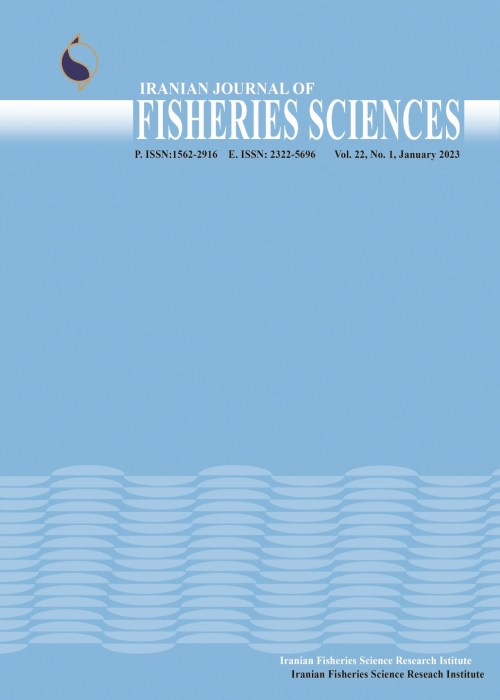Short Communication: Sex related differences in haematological parameters in cultured striped bass (Walbaum, 1752)
This study was designed to evaluate the differences in haematological parameters of males and females of cultured hybrid striped bass (Morone chrysops X Morone saxatilis) (Walbaum, 1752). Fish used in the research were cultured in a recirculating aquaculture system (RAS) of a Sicilian farm in Italy. A total of 160 mature fish (80 males and 80 females) were collected, and blood samples were taken from the caudal vein. Haematological parameters were measured. Weight and total length of fish were also registered. The unpaired t- test statistical method was applied to compare each parameter in the two sexes. In our findings, three haematological parameters: white blood cells WBC (♂ 16.09 ± 7.86; ♀ 20.25 ± 4.62; P < 0.05), mean corpuscular haemoglobin MCH (♂; 24.95 ± 2.92; ♀ 23.46 ± 2.56; P < 0.05) and thrombocytes TC (♂ 53.89 ± 15.06; ♀ 34.03 ± 9.89; P < 0.0001) revealed significant differences between male and female fish. On the contrary, no significant differences were observed in biometric indices and red blood cells, haemoglobin concentration, haematocrit and mean corpuscular volume. Results obtained from our research helps to evaluate the influence of sex on haematology of hybrid striped bass and, consequently, for monitoring changes in the health status of fish.This study was designed to evaluate the differences in haematological parameters of males and females of cultured hybrid striped bass (Morone chrysops X Morone saxatilis) (Walbaum, 1752). Fish used in the research were cultured in a recirculating aquaculture system (RAS) of a Sicilian farm in Italy. A total of 160 mature fish (80 males and 80 females) were collected, and blood samples were taken from the caudal vein. Haematological parameters were measured. Weight and total length of fish were also registered. The unpaired t- test statistical method was applied to compare each parameter in the two sexes. In our findings, three haematological parameters: white blood cells WBC (♂ 16.09 ± 7.86; ♀ 20.25 ± 4.62; P < 0.05), mean corpuscular haemoglobin MCH (♂; 24.95 ± 2.92; ♀ 23.46 ± 2.56; P < 0.05) and thrombocytes TC (♂ 53.89 ± 15.06; ♀ 34.03 ± 9.89; P < 0.0001) revealed significant differences between male and female fish. On the contrary, no significant differences were observed in biometric indices and red blood cells, haemoglobin concentration, haematocrit and mean corpuscular volume. Results obtained from our research helps to evaluate the influence of sex on haematology of hybrid striped bass and, consequently, for monitoring changes in the health status of fish.This study was designed to evaluate the differences in haematological parameters of males and females of cultured hybrid striped bass (Morone chrysops X Morone saxatilis) (Walbaum, 1752). Fish used in the research were cultured in a recirculating aquaculture system (RAS) of a Sicilian farm in Italy. A total of 160 mature fish (80 males and 80 females) were collected, and blood samples were taken from the caudal vein. Haematological parameters were measured. Weight and total length of fish were also registered. The unpaired t- test statistical method was applied to compare each parameter in the two sexes. In our findings, three haematological parameters: white blood cells WBC (♂ 16.09 ± 7.86; ♀ 20.25 ± 4.62; P < 0.05), mean corpuscular haemoglobin MCH (♂; 24.95 ± 2.92; ♀ 23.46 ± 2.56; P < 0.05) and thrombocytes TC (♂ 53.89 ± 15.06; ♀ 34.03 ± 9.89; P < 0.0001) revealed significant differences between male and female fish. On the contrary, no significant differences were observed in biometric indices and red blood cells, haemoglobin concentration, haematocrit and mean corpuscular volume. Results obtained from our research helps to evaluate the influence of sex on haematology of hybrid striped bass and, consequently, for monitoring changes in the health status of fish.This study was designed to evaluate the differences in haematological parameters of males and females of cultured hybrid striped bass (Morone chrysops X Morone saxatilis) (Walbaum, 1752). Fish used in the research were cultured in a recirculating aquaculture system (RAS) of a Sicilian farm in Italy. A total of 160 mature fish (80 males and 80 females) were collected, and blood samples were taken from the caudal vein. Haematological parameters were measured. Weight and total length of fish were also registered. The unpaired t- test statistical method was applied to compare each parameter in the two sexes. In our findings, three haematological parameters: white blood cells WBC (♂ 16.09 ± 7.86; ♀ 20.25 ± 4.62; P < 0.05), mean corpuscular haemoglobin MCH (♂; 24.95 ± 2.92; ♀ 23.46 ± 2.56; P < 0.05) and thrombocytes TC (♂ 53.89 ± 15.06; ♀ 34.03 ± 9.89; P < 0.0001) revealed significant differences between male and female fish. On the contrary, no significant differences were observed in biometric indices and red blood cells, haemoglobin concentration, haematocrit and mean corpuscular volume. Results obtained from our research helps to evaluate the influence of sex on haematology of hybrid striped bass and, consequently, for monitoring changes in the health status of fish.
- حق عضویت دریافتی صرف حمایت از نشریات عضو و نگهداری، تکمیل و توسعه مگیران میشود.
- پرداخت حق اشتراک و دانلود مقالات اجازه بازنشر آن در سایر رسانههای چاپی و دیجیتال را به کاربر نمیدهد.


